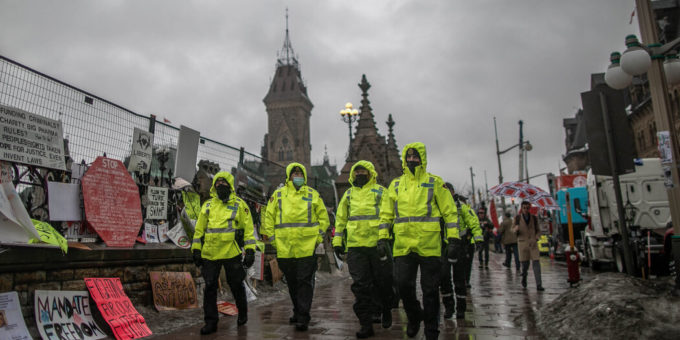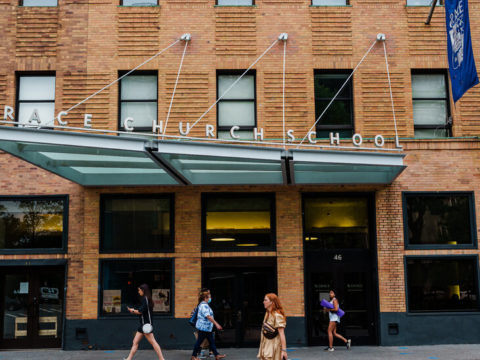
The Ontario provincial police mobilized outside Ottawa’s city center on Thursday, in what appeared to be preparation for a promised clampdown on protesters who have paralyzed the capital of Canada for three weeks.
In the early morning, police officers were seen leaving a convention center near the airport where they had gathered. Police vehicles, which had filled a large parking lot, began to leave.
Five municipal buses were seen idling on a street adjacent to the convention center, and police officers were seen boarding at least two of them, which traveled to the city’s western suburbs. Ontario provincial police officers were seen gathering at major hotels in that area.
Around the Parliament building downtown, construction workers spent the dawn hours putting up 12-foot-high wire fencing in a soggy morning rain, and protesters braced for police action. Among them was Andrew Broe, who said the truckers were exchanging text messages with the protest leadership. He said their instructions were to remain in their trucks, lock the doors and not open them for, anyone including the police.
Addressing the House of Commons on Thursday, Prime Minister Justin Trudeau called for the protesters to go home. “It is high time that these illegal and dangerous activities stop, including here in Ottawa,” he said.
In a sign of intensifying frustration over the protests, on Thursday the scope of a class-action lawsuit against the protesters was expanded to include more workers and businesses whose livelihoods have been upended by the protests. In total, the lawsuit is seeking about 306 million Canadian dollars in compensation for lost income.
The protests began weeks ago with a loosely organized group of truckers objecting to a requirement that they be vaccinated if they cross the U.S.-Canada border. With organizing help from right-wing activists, the protests ballooned into a broader movement opposed to an array of pandemic measures and to Mr. Trudeau generally.
If the clampdown takes place, it could help bring to an end a crisis that has undermined the leadership of Mr. Trudeau and disrupted local residents and the local economy. Truckers and their supporters blocked key border crossings and other routes, impeding commerce and idling automakers’ plants. Some blockaded streets and harassed residents in Ottawa, creating a round-the-clock cacophony in quiet residential neighborhoods. Physical violence has been rare.
Ottawa residents and many Canadians have grown impatient with the sluggishness of the police response, and early this week Ottawa’s police chief resigned amid criticism of law enforcement.
Mr. Trudeau took the rare step this week of declaring a national public order emergency — the first such declaration in half a century — to end the protests. The move extended more robust policing measures across the country, and took aim at both protesters’ fund-raising, which has been deemed a criminal activity, and the demonstrators’ personal and business bank accounts.
On Wednesday during a special City Council meeting, Steve Bell, the interim Ottawa police chief, said officers now had the resources and a plan to end the protest. He did not discuss the timing or particulars of the plan, citing operational reasons, but said officers were ready to use tactics that “are not what we’re used to seeing in Ottawa,” as part of a “lawful” escalation.
“We’re going to take back the entirety of the downtown core,” Mr. Bell said. “We have a good, well-resourced plan to end the occupation.”
The police had begun distributing written notices to protesters in Ottawa on Wednesday warning those remaining to leave the area or face penalties. A few of the truckers have their children with them, and one police notice warned that anyone taking a minor to an illegal protest could face up to five years in prison.
Some protesters have been accompanied by their dogs, and Ottawa municipal officials warned on Thursday that if protesters were separated from their pets during a police action, the animals would be placed in protective care for eight days, at their expense, and would be “considered relinquished” after that.
On Tuesday, the police charged four people with conspiring to murder police officers, part of a group of 13 people charged with planning a violent response if the police tried to break up the blockade of a border crossing between Alberta and Montana at the Canadian village of Coutts.
Around the country there have been signs of the protests losing steam as government leaders and law-enforcement officials, who were reluctant at first to take action, have taken a steadily tougher line.
Border blockades have ended at Windsor, Ontario, linking to Detroit; at Coutts; and, on Wednesday, at Emerson, Manitoba, crossing into North Dakota, among others.
Sarah Maslin Nir contributed reporting.













